Disclosure: We may earn commissions if you purchase products after clicking on a link from our site.
Do you hunt out in the woods? Do you know what to do if you get bitten by a snake? Would you like to learn how to survive a snake bite while hunting? There are many dangers hunters may encounter while hunting in the woods.
You may be vulnerable to wild animal attacks, snake bites, and scorpion stinks, to name a few. In this article, we discuss how to survive a snake bite while hunting in the woods.
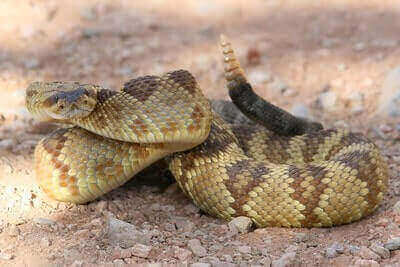
Table of Contents
- 1 How to Survive a Snake Bite While Hunting
- 2 Symptoms of Snake Bites
- 3 DOs AND DONTs WHEN BITTEN BY A SNAKE
- 4 Venomous Snakes In the United States
- 4.1 1. Western Diamondback Rattlesnake
- 4.2 2. Eastern Diamondback Rattlesnake
- 4.3 3. Timber Rattlesnake
- 4.4 4. Sidewinder Rattlesnake
- 4.5 5. Mojave Rattlesnake
- 4.6 6. Santa Catalina Rattlesnake
- 4.7 7. Rock Rattlesnake
- 4.8 8. Speckled Rattlesnake
- 4.9 9. Black-tailed Rattlesnake
- 4.10 10. Pacific Rattlesnake
- 4.11 11. Twin-spotted Rattlesnake
- 4.12 12. Red Diamond Rattlesnake
- 4.13 13. Tiger Rattlesnake
- 4.14 14. Prairie Rattlesnake
- 4.15 15. Massasauga Rattlesnake
- 4.16 16. Pygmy Rattlesnake
- 4.17 17. Cottonmouths
- 4.18 18. Copperhaeds
- 4.19 19. Coral Snakes
- 5 The Bottom Line
How to Survive a Snake Bite While Hunting
- Find Somewhere to Sit
If you get bitten by a snake, quickly move backward with your eyes focused on the snake in the direction it went in and find a safe spot to sit down. You want to sit down and try to relax and be calm. This will slow down the circulation of the venom in your body.
Try to remember the color of the snake and its shape. This information can also be helpful in identifying the species of snake to determine the right antivenom to treat you.
2. Circle the Bite Area
Once you are sitting in a safe place, use a pen, marker, rock, or something to circle the spot where you were bitten. If you have a pen or marker, write down the time you got bitten as much as you can estimate it. This information will be very valuable for the medics who will treat you.
3. Quickly Remove Any Jewelry
Quickly remove any rings, watches, or other jewelry that may be difficult to get off if your limbs swell up. These pieces of jewelry can quickly be trapped as the limbs swell and can be working as a tourniquet which is not good. Additionally, if these pieces of jewelry are stuck on your limbs, they may be difficult to be removed.
4. Get Medical Help
Get medical help as soon as possible. if you are in the United States and have your cell phone on you, call 911 right away. Give them your location, the time you were bitten, the description of the snake, and any symptoms you are experiencing. If you don’t have your phone or can’t get reception, try to get back to your vehicle or your camp as fast as possible.
Additionally, if you are part of a hunting team, immediately whistle or use whatever communication the team uses to get their attention.
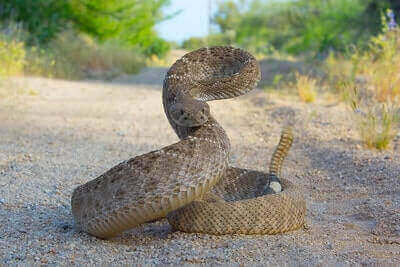
5. Do Not Take Any Medication
Even if you have any painkillers in your pocket or in your car, don’t take any medication to alleviate the pain. These medications interfere with normal blood clotting and it may result in severe internal bleeding. Snake venom can damage blood vessels and with the interference of normal blood clotting, there is a high risk of internal bleeding.
Symptoms of Snake Bites
- A pair of puncture marks at the wound.
- Redness, swelling, bruising, bleeding, or blistering around the bite.
- Severe pain and tenderness at the site of the bite.
- Nausea, vomiting, or diarrhea.
- Difficulty breathing.
- Rapid heart rate, weak pulse, and/or low blood pressure.
- Disturbed vision.
- Increased salivation and sweating.
- Metallic, mint, or rubber taste in the mouth.
- Muscle twitching.
- Numbness or tingling around your face and/or limbs.
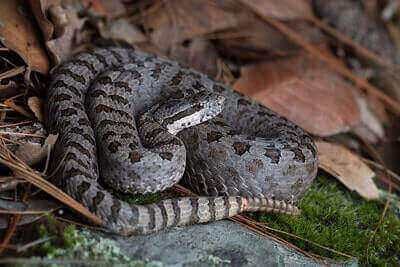
DOs AND DONTs WHEN BITTEN BY A SNAKE
| DOs | DONTs |
|---|---|
| Try to remember the color and shape of the snake. | Do not try to trap, kill, or pick up the snake. |
| Sit down & try to be calm. | Do not apply a tourniquet. |
| Seek medical help immediately. | Do not try to suck out the venom. |
| Circle the bite area and write down the time of the bite. |
Do not slash the wound with a knife. |
| Do not apply ice or immerse the wound in water. | |
|
Do not take any painkillers or drink alcohol as a painkiller. |
|
| Do not drink caffeinated beverages. | |
| Do not try to extract the venom using a “snakebite kit”. | |
| Do not electrocute yourself with a stun gun. | |
| Do not apply first aid or receive it from family, friends, or hunting buddies. |

Venomous Snakes In the United States
There are four groups of venomous snakes in the United States. They are rattlesnakes, copperheads, cottonmouths, and coral snakes. Rattlesnakes are the majority of the venomous snakes found in the United States. Copperhaeds and cottonmouths are related to rattlesnakes and the three groups make up the pit viper family. Coral snakes stand all by themselves with no relationship to the other three groups.
1. Western Diamondback Rattlesnake
The western diamondback rattlesnake is one of the most dangerous snakes found in the western United States. It grows to about 4-6 feet and is usually black and gray. It is responsible for the greatest number of snake bites in the United States.
2. Eastern Diamondback Rattlesnake
The eastern diamondback rattlesnake is the largest venomous snake in the United States. Eastern diamondbacks can be black, brown, or cream and they grow up to about 8 feet. You can find the eastern diamondbacks along the coastal southeastern United States from Louisiana to the coastal plains of North Carolina.

3. Timber Rattlesnake
Timber rattlesnakes are brown and gray with dark black heads and tails. They can also have copper markings across their backs. Timber rattlesnakes can be found in the north in Vermont and New Hampshire as well as in the southeast and midwest.
4. Sidewinder Rattlesnake
The sidewinder rattlesnake is a desert snake and is named after the way it moves across the hot sand in the desert. They have a light sandy color and can grow up to 3 feet. The sidewinder lives in the Mojave and the Sonoran Deserts. There are three subspecies of the sidewinder namely, the Mojave Desert Sidewinder, the Sonoran Desert Sidewinder, and the Colorado Sidewinder.
5. Mojave Rattlesnake
The Mojave rattlesnake is found around the Mojave Desert in the southwest of the United States. They are some of the most venomous snakes in the United States and are considered the most venomous rattlesnakes in the world. Mojave rattlesnake grows up to 3.5 feet.
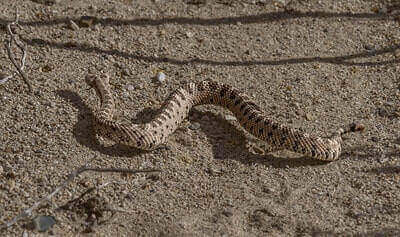
6. Santa Catalina Rattlesnake
This rattlesnake only lives on the island of Santa Catalina, which is off the coast of California. They grow up to 2 feet in length and don’t have rattles.
7. Rock Rattlesnake
The rock rattlesnake is a smaller species of rattlesnake that are found in limestone and sandstone-filled regions. They are light-colored and look like the sandy stones they live around. This works well to camouflage them for their prey.
8. Speckled Rattlesnake
The speckled rattlesnake is a desert-dwelling snake that lives in the southwest regions of the United States and northern Mexico. They are smaller snakes that grow up to 3.5 feet long. It features a speckled pattern that its name is derived from. There are three subspecies of the speckled rattlesnake. They are the Southwestern Speckled rattlesnake, the San Lucan Speckled rattlesnake, and the Panamint rattlesnake.
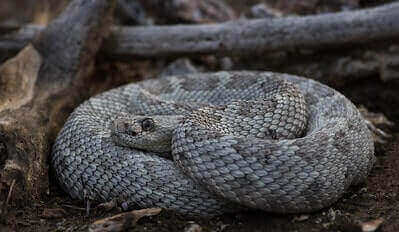
9. Black-tailed Rattlesnake
The black-tailed rattlesnake is a docile member of the rattlesnake species. It rarely bites, is dark-colored with black tails, and grows from 2 to 3.5 feet long. They live in the southwestern parts of the United States.
10. Pacific Rattlesnake
This is one of the most common rattlesnakes in the United States. It is found across the west coast and in the desert regions of the United States. The Pacific rattlesnake has a number of subspecies namely: the Grand Canyon rattlesnake, the Coronado Island rattlesnake, the Arizona black rattlesnake, the Yellow rattlesnake, the Southern Pacific rattlesnake, the Great Basin rattlesnake, and the Northern pacific rattlesnake.
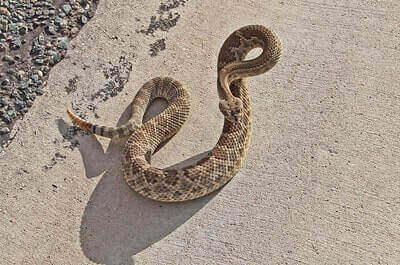
11. Twin-spotted Rattlesnake
The twin-spotted rattlesnake grows up to about 2 feet with a distinct rounder head than other rattlesnakes. They feature a two-spotted pattern that travels down their backs so that they get their name. The twin-spotted rattlesnake lives in southeastern Arizona and Mexico.
12. Red Diamond Rattlesnake
This rattlesnake gets its name from the reddish-brown coloration it is known for. They grow up to 5 feet in length and are found in southern California and the Baja Peninsula. They also feature a striped black and white tail which gives them a distinctive appearance.
13. Tiger Rattlesnake
The tiger rattlesnake is found across the United States in central Arizona and Mexico. They are small rattlesnakes with deadly venom. Tiger rattlesnakes feature a black striping pattern across their gray bodies.

14. Prairie Rattlesnake
The prairie rattlesnake is one of the most distributed rattlesnake species in the United States. They can be found across the Great Plains region of the United States, from northern Mexico to the south of Canada. There are two species namely: the Hopi rattlesnake and the prairie rattlesnake.
15. Massasauga Rattlesnake
This rattlesnake can be found as far south as Texas and up north as Canada. There are three subspecies of the massasauga rattlesnake. They are the Eastern massasauga, the Desert massasauga, and the Western massasauga rattlesnake.
16. Pygmy Rattlesnake
The pygmy rattlesnake is the smallest species of rattlesnake in the United States. They are found in the southeastern United States around the coastal plains regions. Pygmy rattlesnake is one of the least dangerous rattlesnakes found in the United States due to the small size and low-potency venom it possesses. There are three subspecies of this rattlesnake, namely: the Dusky pygmy rattlesnake, the Carolina pygmy rattlesnake, and the Western pygmy rattlesnake.
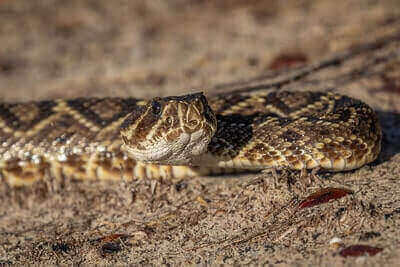
17. Cottonmouths
Cottonmouths are large, venomous aquatic snakes that are members of the pit viper family. It is native to the southeastern United States and has three subspecies. They are less venomous than most species of rattlesnakes, although they are more dangerous than copperheads.
Cottonmouths are found in swampy lowland regions near or in rivers, streams, swamps, and wetlands. Additionally, its subspecies are the Florida cottonmouth, the Western cottonmouth, and the Eastern cottonmouth.
18. Copperhaeds
Copperheads feature distinct copper-colored bodies and brown hourglass patterns across their backs. They also have golden cat-like slitted eyes, distinct pits around their mouths, and triangular heads. They use camouflage as their primary line of defense which results in them being stepped on a lot. This also results in many bites that are not very fatal. Copperheads prefer wooded and forested areas where they can seamlessly blend with.
There are five subspecies of Coppoerheads such as the Northern copperhead, the Southern copperhead, the Broad banded copperhead, the Trans-Pecos copperhead, and the Osage copperhead.
19. Coral Snakes
Coral snakes are different from all of the other venomous snakes found in the United States. They are Elapids which implies that they are closer to cobras and sea snakes than pit vipers. There are about 50 species of coral snakes in the Americas, but only three species in North America. They are brightly colored and feature banding patterns of black, red, and yellow.
Additionally, coral snakes are highly venomous with a neurotoxic venom similar to that of pit vipers. However, they have a poor venom delivery system, are rare, and spend most of their time underbrush and logs. The three species found in the United States are the Arizona coral snake, the Eastern coral snake, and the Texas coral snake.
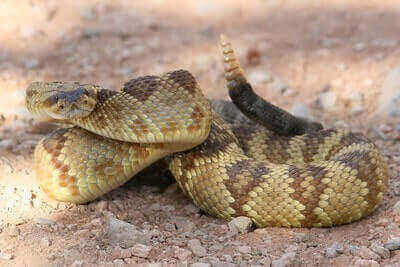
The Bottom Line
There are many dangers that hunters encounter while hunting in the woods. One of the regular dangers is snake bites. Most of the snakes in the United States are venomous and if bitten, you want to get immediate medical help. In this article, we discussed how to survive a snake bite while hunting.
If you are interested in snake guards, ground blinds, hunting gaiters, and hunting boots, then read the best snake guards, the best hunting ground blinds, the best hunting gaiters, and the best hunting boots. Moreover, you can also read how to survive a wild animal attack.